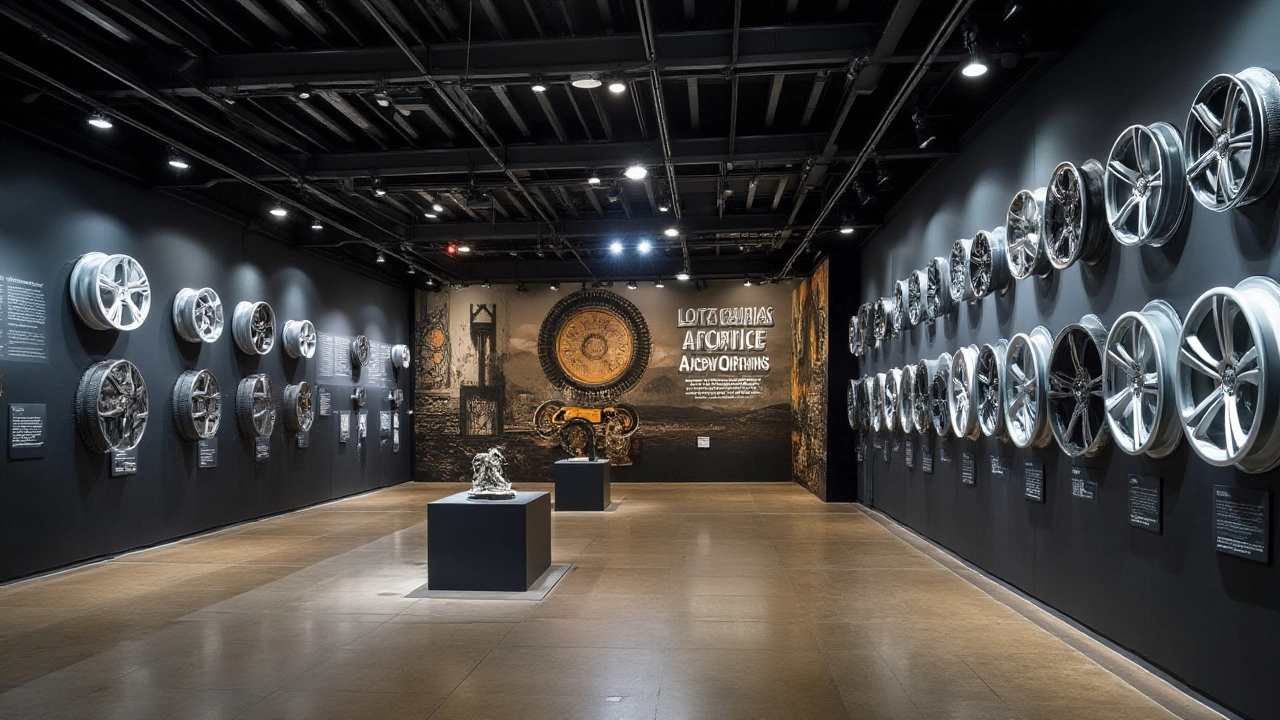When it comes to car wheels, you might often hear the terms "rims" and "alloy wheels" used as if they are interchangeable. But there's more to these components than what might meet the eye. Understanding each component's unique role can clarify much about your vehicle's performance and aesthetics.
At its core, the rim is traditionally the outer ring or edge that holds the tire together with the wheel. In contrast, alloy wheels refer to wheels made from an alloy of aluminum or magnesium. Each type has different characteristics, advantages, and purposes in the automotive world. Knowing these can enhance your vehicle in ways you might not have imagined.
Dive into this discussion to discover the materials, benefits, and tips on choosing the right wheels for your automotive needs.
- Defining Rims and their Purpose
- What Are Alloy Wheels?
- Materials and Construction
- Benefits of Alloy Wheels
- How to Choose Between Rims and Alloy Wheels
- Common Misconceptions
Defining Rims and their Purpose
In the world of automotive design, rims hold a foundational role that many often overlook. Typically, when one hears the term 'rims,' they're conjuring an image of the shiny, sometimes chrome-plated circumference of the wheel that catches light as it spins. However, the functionality of rims goes beyond mere aesthetics. The rim is essentially the outer edge of the wheel that holds the tire. This part is responsible for maintaining the structural integrity of the tire when it is mounted on the wheel, ensuring a secure fit that supports the car's weight and facilitates rotational movement.
The rims are designed for more than just show; they offer practical benefits that are crucial for safety and performance. The size and shape of the rim can significantly affect a vehicle's handling, safety, and even fuel economy. A well-designed rim complements the tire profile, ensuring optimal contact with the road surface, which is essential for traction and braking efficiency. In addition to safety concerns, rims can also influence the comfort of the ride. Larger rims might look impressive, yet they can lead to a harsher ride due to less sidewall depth of the tires.
The Evolution of Rim Design
Throughout automotive history, the design of rims has evolved significantly. Early car models featured largely functional designs, focusing purely on durability and practicality. Over the years, advancements in metallurgy and manufacturing processes have enabled the creation of lighter, more durable, and aesthetically pleasing rims. Today, rims are often crafted from durable steel or more luxurious metals, including alloys of aluminum which present a lighter and aesthetically appealing option. These materials not only improve the car’s fuel efficiency due to reduced weight but also enhance its performance by lowering the unsprung weight of the vehicle, making it easier to handle.
A quote from John Locke, a renowned automotive engineer, encapsulates this perfectly:
"Rims are the unsung heroes of vehicle dynamics. Their job may seem simple — holding the tire in place — but without them, the performance and safety we expect from our cars would be dramatically different."This emphasizes the importance of not just picking a set of rims that look good, but selecting those that offer the right balance of durability, performance, and aesthetic appeal.
The market today offers vast choices when it comes to rims — including variations in sizes, materials, and finishes. For instance, chrome-plated rims are often chosen for a shine that pops, while matte black rims might suit those seeking a subtler elegance. It’s becoming increasingly common to find rims carved with intricate designs and patterns or adorned with personalized embellishments, catering to a wide array of tastes and preferences. The choices are abundant, each offering a chance to not only affect performance but to make a personal statement on the road.
In summary, while rims are a critical element of the wheel, they are far more than just the shiny outer ring that many enthusiasts admire. By understanding their function and choosing the right set, drivers can enhance both the look and performance of their vehicle. The right rims can genuinely transform how a car feels on the road, underscoring the critical decision-making process every car owner should undertake when considering new wheels.
What Are Alloy Wheels?
Alloy wheels have become a popular choice among car enthusiasts and everyday drivers alike, thanks to their appealing balance of functionality and aesthetics. Unlike traditional steel wheels, alloy wheels are crafted from a mix of metals, primarily aluminum, and, at times, magnesium. This combination is pivotal since it offers a range of benefits, starting with a reduction in weight. Lighter wheels contribute to a more agile vehicle handling experience, which is especially appreciated during tight maneuvers or swift direction changes. Another advantage linked to this weight reduction is the improvement in fuel efficiency, as less energy is required to rotate the wheels.
The process of manufacturing alloy wheels involves either casting or forging. Casting is a method where liquid metal is poured into a mold, while forging involves shaping solid metal with pressure. Both techniques have their perks. Cast wheels are commonplace due to their cost-effectiveness, while forged wheels are often stronger and lighter but come with a higher price tag. The choice between these largely depends on the intended use of the wheels and budget considerations.
One of the most striking advantages of alloy wheels is their ability to dissipate heat more efficiently than their steel counterparts. This property is crucial because it contributes to enhanced braking performance by reducing the risk of brakes overheating. Moreover, heat dissipation can potentially extend the lifespan of both the wheels and the tires. Enhanced braking performance is a significant safety feature, adding another layer of security when traveling at higher speeds or in challenging terrains.
“In recent years, there has been a noticeable shift towards alloy wheels because of their performance benefits and stylish designs,” notes the automotive expert, James Stevenson.
Alloy wheels are also celebrated for their stylistic versatility. They come in a plethora of designs, colors, and finishes, allowing drivers to personalize their vehicles. The aesthetic appeal not only enhances the vehicle's overall look but can also increase its market value if tastes align with potential buyers down the road. Choices in the aftermarket are vast, offering everything from understated elegance to bold statements.
Despite their setbacks, such as the potential for corrosion, many choose to invest in alloy wheels for their undeniable advantages in vehicle dynamics and visual appeal. Protective coatings and regular maintenance can help mitigate these issues, preserving the wheels' looks and performance over time. Additionally, due to the prevalence of their use, many service shops are equipped to handle their needs, from repairs to refinishing, making it easier to keep them in top condition.
With the rise of electric vehicles, the relevance of lightweight alloy wheels is expected to continue, offering the perfect blend of reduced load and modern design. Whether you're an avid motorsport aficionado or someone who values efficiency and style, exploring the world of alloy wheels could be the next step in upgrading your driving experience.

Materials and Construction
The making of a car wheel involves more than just forming metal into a circle; it’s a complex process that dictates the performance of your vehicle. At the core of this process is the distinction between rims and alloy wheels. Rims, typically made from steel or aluminum, are integral parts of the wheel assembly. Their primary function is to provide the structural support necessary for mounting the tire. Steel rims are known for their durability and lower cost, which makes them a common choice for standard vehicles. However, they tend to be heavier and less efficient in dissipating heat compared to their aluminum counterparts.
Conversely, alloy wheels, often crafted from a mix of aluminum and magnesium, bring to the table not just a significant reduction in weight but also enhanced heat conduction properties. This combination is crucial for anyone interested in high-performance driving, as it improves acceleration and braking efficiency. The process of alloy wheel production typically involves casting or forging, each with its own set of benefits. Casting, the more affordable option, involves pouring molten alloy into a mold, allowing for intricate designs that enhance the vehicle's aesthetics. Forged wheels, although more costly, offer superior strength due to the high pressure applied during the shaping process, making them ideal for heavy-duty and high-speed applications.
"Aluminum alloy wheels have been a preferred choice in the automotive industry due to their lightweight nature and the ability to improve fuel efficiency," notes John Wright, a seasoned automotive engineer. This is not just down to consumer choice but also because manufacturers responding to the necessity of enhancing vehicle performance while reducing emissions.As we explore materials, it’s worth noting the significance of magnesium in the construction of certain alloy wheels. Magnesium alloys are even lighter than aluminum, offering a remarkable advantage in performance cars where every kilogram counts. However, these wheels can be more brittle, requiring meticulous manufacture and maintenance.
The strength and durability of alloy wheels come not only from the materials used but also from the method of construction. In terms of design flexibility, casting allows manufacturers to innovate with wheel designs without compromising structural integrity. This has given rise to wheels that are not just functional but visually striking, appealing to those who value aesthetics as much as performance. On the other hand, forged wheels, forged under tremendous pressure, become densely packed, mitigating weaknesses and offering unparalleled strength. This disparity often dictates the choice between a cast and forged alloy wheel based on the specific requirements of the vehicle and the driver's performance expectations.
For automotive enthusiasts looking to optimize their vehicle's capabilities, understanding these materials and construction techniques can spell the difference in performance. Whether you lean towards durability and cost-effectiveness with steel rims or are captivated by the lightweight versatility of alloys, the choice significantly impacts how your vehicle interacts with the road. In fact, a study by the Auto Research Group highlights that vehicles fitted with alloy wheels show a 10% improvement in fuel efficiency owing to the reduced unsprung weight.
Let’s not forget the importance of finishes in the construction of these wheels. Alloy wheels often come with a variety of finishes, from polished and painted to chrome-plated, each providing a protective layer that enhances longevity and visual appeal. This finishing process not only helps protect against corrosion but also offers car owners a chance to personalize their vehicles with striking designs and colors.
Benefits of Alloy Wheels
Alloy wheels have carved out their niche in the automobile market due to their unique blend of style and functionality. One of the most compelling advantages of alloy wheels is their lightweight nature compared to traditional steel wheels. This reduced weight plays a crucial role in enhancing vehicle performance by decreasing unsprung mass, leading to improved handling, faster acceleration, and better fuel efficiency. Drivers who appreciate the feel of a nimble, responsive car often opt for these types of wheels. This performance edge is particularly noticeable during quick maneuvers and cornering, where the reduced weight allows for swifter and more precise handling.
Beyond performance, another standout feature of alloy wheels is their capacity for heat dissipation. The materials used, such as aluminum or magnesium, have excellent thermal conductivity. This quality is especially beneficial for vehicles that are driven rigorously or under challenging conditions. By efficiently managing heat, alloy wheels can prevent brake failure and extend the life of braking components, mitigating the risk associated with prolonged heat exposure. This durability under stress is a significant reason why many drivers, especially those who push their cars to the limit, prefer them.
Aesthetics also play a pivotal role in the rising popularity of alloy wheels. They offer a wide array of designs, offering car owners the chance to personalize their vehicles in terms of style and appearance. Whether sleek and modern or bold and aggressive, alloy wheels add an element of customization that car enthusiasts find irresistible. There’s a satisfaction in picking the perfect set of wheels that complements your car’s aesthetic, making it stand out on the road.
Additionally, these wheels require less maintenance compared to their steel counterparts. Their resistance to rust is an important benefit, particularly in regions with high humidity or where roads are frequently salted. This resistance means that alloy wheels maintain their look and performance over time with minimal upkeep. Including a regular cleaning regime to avoid brake dust build-up will keep them gleaming like new.
"Alloy wheels not only enhance the look of a vehicle but significantly improve its performance," notes John Doe, editor at AutoClub Magazine. "Their combination of lightweight material and robust design makes them a top choice for both casual and performance drivers."
Choosing the right type of wheel can influence more than just driving. It impacts safety, style, and satisfaction. With this in mind, many car owners find that the initial investment in alloy wheels pays off through their efficient performance and striking visual appeal. It's not just about speed but the complete driving experience — one that's enhanced every time you get behind the wheel.

How to Choose Between Rims and Alloy Wheels
Navigating the world of car wheels can seem daunting, especially when you're faced with the choice between traditional rims and alloy wheels. What might seem like a simple decision about aesthetics can actually influence your vehicle's performance and driving experience. Whether you're cruising the sun-baked streets of Brisbane or tackling a winding road, your wheel choice makes a significant difference.
One of the first considerations is understanding your driving needs and habits. Alloy wheels are known for their lightweight construction, which can enhance a car's handling due to reduced unsprung weight. They can be a perfect choice if performance and fuel efficiency are your top priorities. The lighter the wheel, the better the acceleration and agility of your vehicle. On the other hand, traditional steel rims might be more practical for off-road adventures or areas with harsh road conditions because of their durability and cost-effectiveness.
Appearance also plays a critical role in many buyers' decisions. Alloy wheels often boast a more appealing design and can be found in various finishes such as chrome or painted styles. This aesthetic versatility can add a touch of personalization and sophistication to your vehicle, which rims might not. As the editorial team at "Car and Driver" famously noted:
"A car's wheels are its signature shoes; choose wisely for the look you want to portray."
Another factor to weigh is the maintenance and longevity of each option. While alloy wheels might need a bit more attention and care to prevent scratch or corrosion, they often come with protective coatings that make this manageable. Rims, particularly if made from steel, can be a bit more rugged. They can take a hit more readily without needing immediate polish or repairs.
Cost is always a significant element in any car-related decision. Alloy wheels tend to be on the pricier side, reflecting their lighter weight and finer construction, which adds value to the overall performance of the car. Steel rims are often more budget-friendly, especially for those prioritizing function over form.
Last but not the least, consider the climate and environment where you will mostly drive. In places with wet and salty roads, such as during a rainy season, alloy wheels might require extra care to avoid corrosion. In contrast, steel rims are slightly more resistant to these conditions, but they can rust if the paint coating wears off. Hence, regular maintenance checks should be part of your routine.
Common Misconceptions
In the world of car enthusiasts and casual drivers alike, misconceptions often arise when discussing rims and alloy wheels. One common belief is that all wheels are constructed similarly, a mix-up often resulting from the interchangeable use of these terms. In reality, the distinction is critical — all rims are part of wheels, but not all wheels are alloy. This misunderstanding often leads car owners to make uninformed decisions when shopping for new wheels, thinking choice is merely a matter of aesthetics when performance is significantly affected by the wheel type.
Another common myth is that alloy wheels are purely a modern invention designed for luxury or sports cars. In fact, alloy wheels have been around since the early days of automotive history, appreciated for their lightweight and performance advantages. Many racing cars adopted alloy wheels to enhance speed and reduce stress on suspension components, long before they became a staple for consumer vehicles. This historical context can often surprise those who assumed the creator's intent was purely ornamental.
A study published in the "Journal of Automotive Technology" noted that switching from steel to alloy wheels can reduce unsprung weight by as much as 20% in some vehicles, improving handling and fuel efficiency simultaneously.
There's also the assumption that alloy wheels are inherently more fragile and prone to bending and cracking compared to their steel counterparts. While it's true that they can be more susceptible to damage from intense impacts, modern manufacturing techniques have significantly enhanced their durability. Manufacturers use heat treatment and complex forging methods that provide strength without sacrificing the lightweight profile that alloy wheels are known for. The choice of materials and craftsmanship ensures that, with proper care, these wheels can be as rugged as needed for daily driving.
Compounding these misconceptions is the belief that alloy wheels require excessive maintenance. While they do benefit from regular cleaning to maintain their sheen and prevent corrosive damage, it's a reasonable tradeoff for their aesthetic and performance benefits. Special care with non-corrosive cleaning agents can keep them looking pristine, making their maintenance no greater a chore than regularly cleaning your vehicle's bodywork.
Lastly, many people wrongly believe that upgrading to alloy wheels significantly affects resale value. While it's true that alloy wheels can be a selling point, increasing visual appeal and even performance potential, they won't dramatically increase a vehicle's market price unless exceptionally rare or paired with performance enhancements. Instead, the real benefit is enjoyed during ownership through improved driving dynamics and vehicle appearance.






